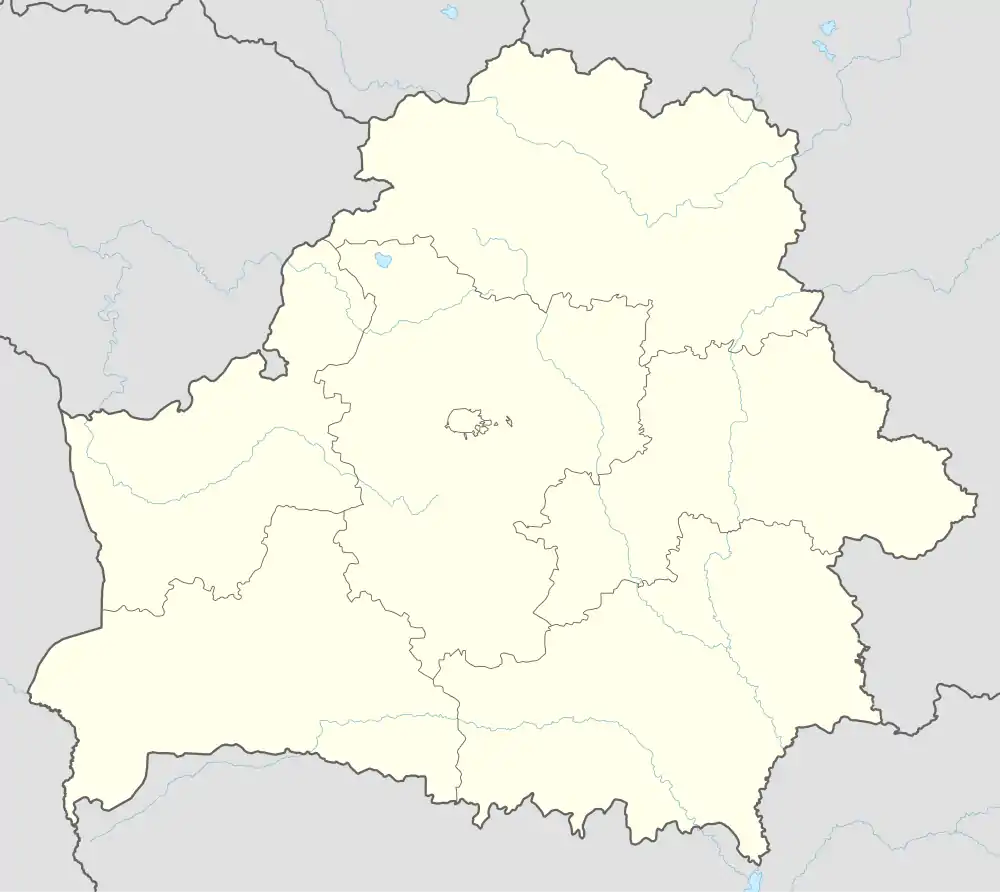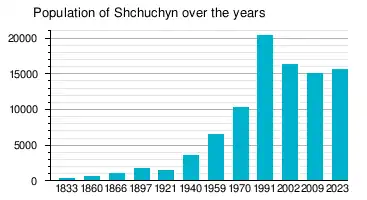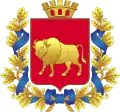Shchuchyn
Shchuchyn[lower-alpha 1] (Belarusian: Шчучын, romanized: Ščučyn,[lower-alpha 2] ⓘ; Russian: Щучин, romanized: Shchuchin, IPA: [ˈɕːʉtɕɪn]; Polish: Szczuczyn; Yiddish: שטשוטשין, romanized: Shtshutshin) is a town in Grodno Region, Belarus.[1] It serves as the administrative center of Shchuchyn District.[1] As of 2023, it has a population of 15,653.[1]
Shchuchyn
| |
|---|---|
Town | |
.jpg.webp) Svaboda Square in Shchuchyn | |
 Flag  Coat of arms | |
 Shchuchyn | |
| Coordinates: 53°37′N 24°44′E | |
| Country | Belarus |
| Region | Grodno Region |
| District | Shchuchyn District |
| Population (2023)[1] | |
| • Total | 15,653 |
| Time zone | UTC+3 (MSK) |
| Postal code | 231511, 231513 |
| Area code | +375 1514 |
| License plate | 4 |
| Website | schuchin |
History
The first known official written mention of Shchuchyn is recorded in 1436, but its foundation as a settlement dates back to 1537, when 'Shchuchyn was mentioned in the Book of Acts of the Lithuanian Metrica (the Book of Lithuanian vital records), kept in the Governmental archive in Lithuania.
Ownership of Shchuchyn passed from one noble family to another: The Radziwiłł family, then the Drutskiya-Liubetskis, the Scipions, and others ruled Shchuchyn in turn. In the 15th–18th centuries, Shchuchyn became a member of the Lida council of the Vilnius office of voivode. In the first half of the 17th century, Shchuchyn was governed by the outsider marshal of the Lithuanian principality, Scipio de Campo. Shchuchyn was an average-sized privately owned village in terms of population.
A Catholic Monasterial Order was established 1726 in Shchuchyn by the resolution of the Sejm. The Board of Shchuchyn was considered to be one of the biggest in Belarus.
Shchuchyn was subject to ruin and ravage more than once in its history. The biggest was in the time of the North War, after the town was seized by the Swedish king Karl XII. After the third partition of the Polish–Lithuanian Commonwealth in 1795, Shchuchyn became a part of the Russian Empire. In June 1812 Shchuchyn was occupied by French troops. And again in 1915, by the German Kaiser. In 1919 the Red Army attempted to seize Belarusian land by taking and fortifying the Martinkantsy - Shchuchyn - Shchara - lake Vygonovskoe line. However, the superior defence forces of the "Land of Grodnenskaya", together with Poland, forced the Red Army back. In 1939, Western Belarus, together with Shchuchyn, went under the control of the Soviet authorities. In World War II, Shchuchyn was occupied by German troops.
During the Nazi occupation from 25 June 1941 until 13 July 1944 the Nazi forces killed about 2180 Jews from the Shchuchyn ghetto with the majority of them killed on 10(9) May 1942.[2][3]
In 1962, Shchuchyn was granted town status.
Air base
Until the collapse of the Soviet Union Shchuchyn was a home of one of the biggest Soviet air bases with over 5,000 personnel assigned to it in the 1990s. The history of the Soviet air force presence in the city goes back into 1941 with a wing of Polikarpov I-16. The air base hosted different types of the Soviet planes throughout the years, such as IL-28, MiG-15, MiG-19, An-14, MiG-21, MiG-23, MiG-25, and others. Most famously in the early 1990s it was a home of about 40 MiG-25BM defense-suppression aircraft, which represents the vast majority of this modification of MiG-25 ever produced. The base was controlled by the 95th air wing. The base's runway is 2,500 meters long.
Industry
The economy of Shchuchyn is primarily based on industries such as agriculture, food processing, and timber production. The surrounding region is known for its fertile lands, which support agricultural activities. Major businesses are JSC “Shchuchyn plant “Avtoprovod” (found in 1958), JSC "Shchuchyn butter-cheese factory" and a bread factory.
Education
Primary and secondary education: three primary schools (grades one through twelve), a vocational technical school (VTS), a gymnasium. Also there are six government run daycare centres.
Demographics

Population of Shchuchyn: 1833 — 327;[4] 1866 — 1088;[5] 1897 — 1742; 1921 — 1539; 1940 — about 3500; 1959 — about 6500; 1970 — 10.3 thousands; 1991 — 14.4 thousands;[6] 2002 — 16.3 thousands; 2006 — 15.8 thousands; 2009 — 15'042.[7]
Notable people
- Onufry Pietraszkiewicz, poet
- Fania Bergstein, poet
Climate
The Köppen Climate Classification subtype for this climate is "Dfb" (Warm Summer Continental Climate).[8]
References
- "Численность населения на 1 января 2023 г. и среднегодовая численность населения за 2022 год по Республике Беларусь в разрезе областей, районов, городов, поселков городского типа". belsat.gov.by. Archived from the original on 17 April 2023. Retrieved 5 August 2023.
- "Yahad - in Unum".
- Адамушко В. И., Бирюкова О. В., Крюк В. П., Кудрякова Г. А. «Справочник о местах принудительного содержания гражданского населения на оккупированной территории Беларуси 1941-1944». — Мн.: Национальный архив Республики Беларусь, Государственный комитет по архивам и делопроизводству Республики Беларусь, 2001. — 158 с. — 2000 экз. — ISBN 985-6372-19-4
- Шчучын Archived 2010-07-19 at the Wayback Machine // Літаратура/Нашы гарады|к
- // Літаратура/Геаграфічны слоўнік Каралеўства Польскага|11 S. 864.
- Щучин // Літаратура/Вялікі энцыкляпэдычны слоўнік
- Перепись населения — 2009. Гродненская область Archived 2010-09-18 at the Wayback Machine(in Russian) Нацыянальны статыстычны камітэт Рэспублікі Беларусь
- Climate Summary for Shchuchyn
External links
- Photos on Radzima.org
- Photo gallery of the town (in Russian)
- Slownik Geograficzny Entry: Szczuczyn
- Diocese of Grodno. Site of the Roman Catholic Church in Belarus
- «Scucin - the city of aviators» Site about Scucin and its long avia history
- Shchuchyn, Belarus at JewishGen
